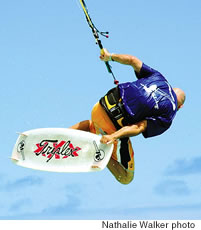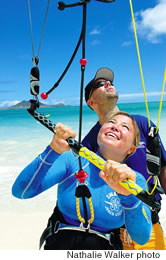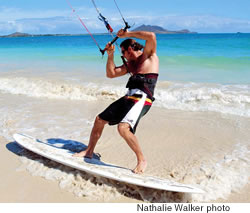Oh, Go Fly A Kite!
Kiteboarding is just five years old, but it’s the hottest sport in Hawaii

By .(JavaScript must be enabled to view this email address)
E-mail this story | Print this page | Archive | RSS

Kiteboarding instructor Greg
Lane goes no hands!
Some of the most beautiful scenes in the world are out there in the wind. Just ask any kite-boarder who has been whisked across the ocean with nothing but white caps and blue skies ahead, and they’ll tell you harnessing this unpredictable force of Mother Nature has created some of their most mind-altering experiences.
Kiteboarding is the fastest-growing watersport in the world - it’s popping up anywhere there are beaches and wind - from Africa to South America to Europe and Asia, and right here in Hawaii. Combining wake-boarding, windsurfing and kite-flying, kiteboarders - strapped into a high-tech wakeboard or even surf-board and holding onto a control bar connected to a large kite - propel themselves across bodies of water at warp speeds, hoping to catch a little air.

Josh Seymour jumps high enough to
grab his board
“Most of our early customers for kiteboarding were our windsurfing customers,” says Carol Naish, owner of Naish Hawaii, which was one of the first to offer kite-boarding equipment and instruction, in 2000. “When kiteboarding first started about five years ago, it seemed that most of the people who were getting into it were the kind that got bored with windsurfing. They felt they weren’t getting the extreme sport experience that they were looking for.”
Kiteboarding is most certainly an extreme sport. Today’s kiteboarders are pushing the limits of physics, moving at top speeds of 50 mph across the water’s surface and performing tricks and jumps that launch them up to 65 feet in the air.
But the great thing about the sport, say kiteboarders, is its versatility. Anyone can do it, even if you don’t have previous watersport experience. It’s portable: You can pack your equipment neatly into a backpack and stick your board in the car. You can go fast or slow, jump upside down or just float along on top of the water.
Not only that, but there’s a fairly quick learning curve with kiteboarding, compared to windsurfing.
“There’s a running joke,” says Naish, “‘What’s the difference between an entry-level kiteboarder and a pro kiteboarder?‘The answer is ‘six months!’
“People compare it to skiing and snowboarding. You don’t just step on the board and fly away, but it’s got a pretty quick learning curve. The initial couple of lessons are probably harder than the entry lessons of windsurfing, but to become proficient at it, it’s much quicker.”
An average person learning to kiteboard might require anywhere from two to six lessons to really get the hang of things.

Hawaiian Water Sports instructor
Josh Seymour shows Joy
Magelssen how to work the kite
People are usually so excited after the first lesson, they’re just hooked!” says Greg Lane, kite-boarding instructor for Caveman Kitesurfing, who also supplies the lessons for Naish Hawaii.
One lesson will cost you between $85 and $125 and lasts one-and-a-half to two hours.
Most people learn to kiteboard on Kailua Beach because of its sandy bottom and ideal wind direction, though other kiteboarding spots on Oahu include Hawaii Kai and the South Shore when the winds are right, and gusty Mokuleia beach - a spot for the more experienced.
Colorful kites dot the sky most windy days in Kailua. “It’s like going to a hot air balloon festival and seeing all the balloons of all different colors up in the sky,” says Lane, 49, a former gymnast. “It’s beautiful.

Setting up your
kiteboarding gear takes
just minutes, as Seymour
shows Magelssen
“Everything I’ve done - from cliff diving to surfing in hurricane waves to sky-diving - I’d give everything up just for the short time I’ve been kiteboarding.”
Local surfer Joy Magelssen has been surfing since she was 9 years old, and decided to take a couple of kite-boarding lessons from Hawaiian Water Sports with her father and sister.
“I thought it would be more physically draining,” she says of her first lesson. “But it was really fun doing body drags in the water and going fast as the kite pulls you. The wind powered it all.”
Only when the winds are up are kiters truly out in force. “The good times for winds are usually in the early morning or late afternoon, and when the wind is about12-18 mph,” says Tony Groman, kiteboarding instructor and owner of Caveman Kitesurfing. “Any windier than that and people who don’t know what they’re doing will end up back on the beach or up in the trees.”

Caveman Kitesurfing owner Tony Groman
uses an old longboard on days when the
winds aren’t strong enough
Because the winds can be unpredictable, it can be hard to set up a lesson in advance. Groman says they currently have 24 people on their waiting list for lessons.
Kiteboarding has created what I like to call “wind junkies,” people who use every possible mechanism to check the strength of the winds. These days there’s a lot, too, from the traditional watching the news forecast to checking NOAA buoys to web cams to expensive wind meters you can purchase and take to the beach. There’s even a web-site, Ikitesurf.com, which charges a fee to receive wind alerts on your phone when the winds are good enough for kiteboarding.
Naish says about 50 percent of the daily calls they receive at their Kailua shop are from kiteboarders who are checking the winds before they make the trek out to Kailua.
Then there are those like Lane and Groman who have been wind junkies long enough that they only need
Page 1 of 2 pages for this story 1 2 >
E-mail this story | Print this page | Comments (0) | Archive | RSS
Most Recent Comment(s):








